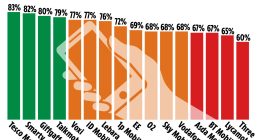
Opinions expressed by Entrepreneur contributors are their own.
Not so long ago, expanding your brand internationally meant one of two things: building a brick and mortar presence in each new country, or navigating a labyrinth of fragmented trade regulations, carrier options, customs, duties, local taxes, currencies and languages to ship your products there through ecommerce. Plenty of large brands and retailers have tried and failed. For smaller, direct-to-consumer brands, the costs and challenges were insurmountable, but all of that has now changed.
Taking your ecommerce brand international can catapult growth — if you do it right. Rising ecommerce brands in the U.S. often find that there is name recognition and pent-up demand for their product overseas; what they lack is the ability to manage the financial side and the post-purchase piece of the puzzle — international payment processing, fulfillment, shipping and returns. The good news is that for today’s ecommerce brands, going international is simply a matter of finding the right apps and partners.
Cross-border solutions
In the past few years, technologies have emerged to make global fulfillment a real possibility for even the smallest D2C brands. Cross-border solutions and payment systems simplify the complexities of international shipping and returns. These apps and platforms are built to process payments in multiple currencies, expedite customs clearance and automate the collection of duties, fees and local taxes.
You don’t have to keep abreast of international shipping laws and customs regulations in each country, because they do it all for you. Even better, they integrate fully into the shopping cart checkout process, so there are no surprises. Customers know exactly what they’re going to pay before they checkout.
Global fulfillment
Such cross-border solutions make international expansion infinitely easier, but only if your fulfillment partner has global capabilities, the necessary systems and integrated technologies. A global 3PL can help you save on shipping and fulfillment costs while enabling rapid growth.
Proper packaging, labeling and shipping help qualified brands take advantage of de minimis thresholds and avoid or reduce import duties wherever possible. Automation and robotics ensure that fulfillment operations can quickly ramp up to meet sudden peaks in demand or rapid growth. Experience and accuracy in picking, packing and labeling can prevent costly customs delays, reduce losses and increase your success rate in certain countries.
Lastly, multiple fulfillment center locations give you the option to move inventory closer to your customers to take advantage of lower shipping costs and faster delivery times. As order volume grows, they may even be able to add international locations to meet local demand, saving you even more on import duties and fees.
Related: 3 Steps to a Successful International Expansion
Multiple shipping options
A global fulfillment partner, in tandem with cross-border shipping solutions, gives your ecommerce brand access to a large network of global shipping carriers, as well as local carriers in each country. By pooling volume and negotiating freight discounts, they can help lower your cross-border shipping costs. Sophisticated systems route your packages the most efficient way, often using a hybrid of international and local carriers so you can also take advantage of local shipping rates, complete with real-time tracking and returns services. In addition, relationships with multiple carriers give you more options for expedited shipping, which improves the international shopping experience for your customers.
Related: How to Succeed in International Markets
Injecting goods into the U.S. market
The same cross-border solutions, fulfillment partners and shipping networks that make it easy to export goods from the U.S. also make it easier and more affordable for international brands to expand into the U.S. market. Off-shore distribution centers can ease customs clearance and lower or eliminate import duties for qualified shipments.
The fact is, for today’s ecommerce brands, going international is now one of the simplest and most affordable ways to catapult growth. If you’ve been holding off because you thought it was too complicated, it’s time to take another look. International fulfillment will never be simple, but today’s cross-border solutions, shipping and fulfillment capabilities make it a realistic option for even the smallest brands.
Related: 7 Rules for Shipping Internationally
This article is from Entrepreneur.com








